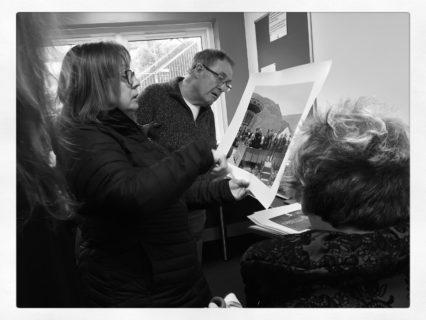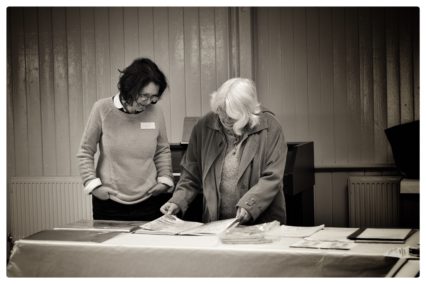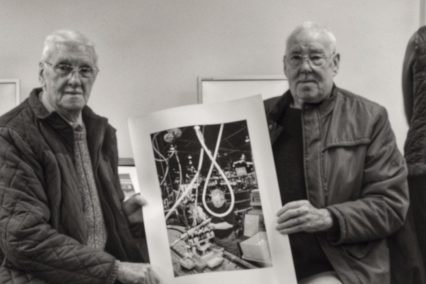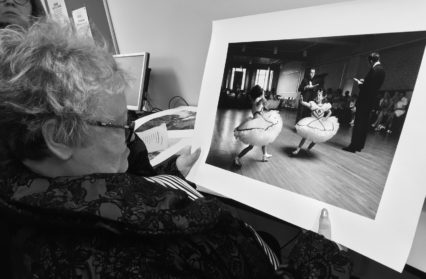When David Hurn told Gayle Rogers that he’d like to put on a solo show at the Workers Gallery – in her words, “a tiny, unfunded venue” in Ynyshir in the Rhondda – the resident artist and gallerist confesses, “I was so excited, I nearly fainted with shock”. Perhaps she shouldn’t have been so surprised. The Magnum photographer not only has a longstanding association with and affection for the Valleys but also a strong preference for exhibiting in places just like the Workers: “I enjoy the enthusiasm and ambition created in the smaller galleries much more than the predictability of the more obvious establishment venues.”
 Just as Public Service Broadcasting recorded and subsequently performed their 2017 LP Every Valley at the Ebbw Vale Institute, at the heart of the former mining community whose story the album tells, so were Hurn’s photos – 45 in total, taken between 1967 and 2019 – exhibited at the very centre of the area in which they were taken, literally and by design. “I’ve shot so many pictures in Wales that I can more or less pick anywhere in Wales and do a 25-mile radius”, Hurn told Buzz. “That makes the show very much a local community one, because it’s all to do with pictures people can associate with.” Community is just as important to Rogers, whose motivation for helping to establish the Workers in Ynyshir’s former library building in 2014 was “to retain at least one place in the village where anyone could visit for free and socialise with others in a warm friendly environment”.
Just as Public Service Broadcasting recorded and subsequently performed their 2017 LP Every Valley at the Ebbw Vale Institute, at the heart of the former mining community whose story the album tells, so were Hurn’s photos – 45 in total, taken between 1967 and 2019 – exhibited at the very centre of the area in which they were taken, literally and by design. “I’ve shot so many pictures in Wales that I can more or less pick anywhere in Wales and do a 25-mile radius”, Hurn told Buzz. “That makes the show very much a local community one, because it’s all to do with pictures people can associate with.” Community is just as important to Rogers, whose motivation for helping to establish the Workers in Ynyshir’s former library building in 2014 was “to retain at least one place in the village where anyone could visit for free and socialise with others in a warm friendly environment”.
Ynyshir: 25 Mile Radius was never going to be “just” an exhibition of some pictures; on the contrary, Hurn’s vision from the outset was that it “should be the base for school/club/enthusiast activities”. Those activities included everything from an “in conversation” event featuring Hurn and fellow photographers Dan Wood and Paul Cabuts, to a Creative Community Day at which visitors were encouraged to create their own artistic responses to the images. The founder of the hugely influential School of Documentary Photography in Newport, Hurn has always been passionate about engaging and inspiring younger generations, and so the exhibition programme also saw him working directly with local primary-school children and a drawing workshop that invited young people to insert themselves into the photos. As he explained to Buzz, “Photography is open to anybody to do … I’m trying to say to young people – you don’t have to think of it as some esoteric art thing that’s not for you.”
 As the closing date of the exhibition approached, Rogers found herself with mixed feelings. “Part of me didn’t want the show to end because it had had such a positive impact on us all. People visited the show and laughed out loud at certain photographs and I had never seen that in the gallery before. People came back to the same show again and again and I had never seen that before either. The show was special and it engaged with people of all ages.” And yet, she admits, “Another part of me realised that some people simply couldn’t get to the show and that seemed wrong.” What to do? Easy: take the show to those people.
As the closing date of the exhibition approached, Rogers found herself with mixed feelings. “Part of me didn’t want the show to end because it had had such a positive impact on us all. People visited the show and laughed out loud at certain photographs and I had never seen that in the gallery before. People came back to the same show again and again and I had never seen that before either. The show was special and it engaged with people of all ages.” And yet, she admits, “Another part of me realised that some people simply couldn’t get to the show and that seemed wrong.” What to do? Easy: take the show to those people.
In his book On Being a Photographer: A Practical Guide, Hurn declares “Photographers should not put pictures in a box under their beds and be the only ones that see them.” Once again, then, it shouldn’t have come as much of a surprise that he was only too happy for his pictures to be put into a box and instead taken out into the community to find a wider audience, even at the risk that the prints would be damaged in the process. Being unframed and unsigned, they were both more easily portable and less valuable than they might otherwise have been – though their large format did demand equally large tables on which they could be displayed by Rogers and her team of Rhondda Creative Community Group volunteers, which unfortunately ruled out some potential venues.
Nevertheless, the Art Box Tour called at a number of different places over the course of a week and a half, giving Ynyshir: 25 Mile Radius a rich afterlife beyond the four walls of the Workers. Whereas the activities surrounding the original exhibition were primarily aimed at engaging younger members of the community, most of the more than 100 additional people who saw the show in its mobile form were elderly: residents in sheltered accommodation, members of a local historical society, attendees of a dementia support group in Treorchy. “We identified places that would have older groups of people already meeting up”, Rogers says, “and we were particularly keen to visit places in the valley where the gallery is – particularly Maerdy and Ferndale where people often refer to the area as the ‘forgotten valley’.”
 Rogers argues that the tour “was all about remembering and connecting”, and this is the route by which many people came to an appreciation of Hurn’s pictures. Mild initial interest gradually gave way to fond reminiscence: “You would show a photograph that inspired a story or memory and they became animated and started to interact with us and each other.” The image that generated the most positive response was that of two sheep taking shelter in a roadside sentry box on a wet and windswept Welsh hillside: “One lady said, ‘See, they say that sheep are stupid, but they are not – look at these two keeping dry. Obviously they are Valleys sheep – and they are not stupid, are they?!’” Hurn has claimed that “Photography is about communication”, and the Art Box Tour was not received passively; on the contrary, it prompted conversation and dialogue.
Rogers argues that the tour “was all about remembering and connecting”, and this is the route by which many people came to an appreciation of Hurn’s pictures. Mild initial interest gradually gave way to fond reminiscence: “You would show a photograph that inspired a story or memory and they became animated and started to interact with us and each other.” The image that generated the most positive response was that of two sheep taking shelter in a roadside sentry box on a wet and windswept Welsh hillside: “One lady said, ‘See, they say that sheep are stupid, but they are not – look at these two keeping dry. Obviously they are Valleys sheep – and they are not stupid, are they?!’” Hurn has claimed that “Photography is about communication”, and the Art Box Tour was not received passively; on the contrary, it prompted conversation and dialogue.
Rogers’ abiding memory of the impact of the photos is that there were “always smiles and always laughs everywhere we took them, and that’s something rare and really made the experience universal and worthwhile”. She freely admits that mobile exhibitions are nothing new – it’s not thinking outside the box to put a show in one – but was surprised at “how this particular initiative captured the interest and imagination of so many people”. Reflecting on the reasons for the Art Box Tour’s extraordinary success, she cites accessibility as being key: “Perhaps it was the love the volunteers had for the work and the wonderful quality and relevance of that work to the audience. One gentleman said to me, ‘It was a privilege to see such work and to be able to touch and hold it myself’, so being able to handle the ‘precious’ photographs meant they connected more intimately with people. They weren’t out of reach on a gallery wall in a place [people] could never get to.”
A short follow-up questionnaire confirmed general enthusiasm for similar initiatives in the future. “I’m not sure how we follow this”, says Rogers, “but there is a demand and dare I say a need for us to do more of this type of ‘exhibiting’.” This, I think, is an extremely important point. Talking to the Guardian about “the North” following his shortlisting for this year’s Portico Prize, author Benjamin Myers commented: “Many ex-mining villages in my homeland of Durham have just voted for the Conservative government. Recent history has been forgotten because it is not taught in schools and consequently an entire generation of disenfranchised miners and shipbuilders have been forgotten about. Battles literally fought in our lifetime are now rendered meaningless; the 1980s might as well be as distant as the 1780s.” Photos like Hurn’s are indeed about “remembering and connecting”, and as such are the potential antidote to the lamentable situation identified by Myers. A valuable reminder of recent social history, they jolt the viewer out of ignorance or forgetfulness, and help to connect people to the past and each other.
(All of the photos credited to Tracey Leonard)












